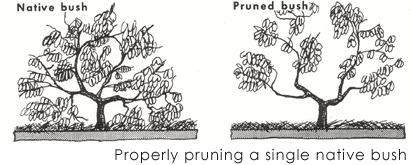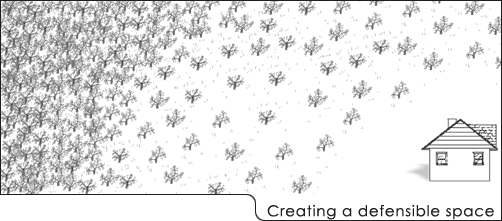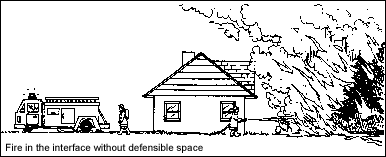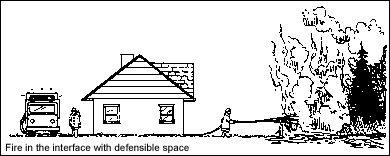Click here for a slide show of Weed Removal Methods
Removal of Hazardous Vegetation Conditions will help Prevent Wildfires
1. Grass, noxious weeds, trash, rubbish, and other flammable material need to be cut and removed from vacant lots, yards, courtyards, parkways, and other locations. These types of vegetation, when dry, become a fire hazard and must be maintained throughout the year.
2. Trees and branches – Remove any portion of a tree that extends within 10 feet of the outlet of any roof, chimney, or stovepipe.
3. Native brush and chaparral near any improved property (structures) need to be cleared or thinned. All ground litter must be removed from vacant lots, yards, courtyards, parkways, and other locations. The diagrams below show how to properly prune a single native bush (see illustration below) and how to create a defensible space around a home (see illustration below) or other structure by simply removing the dead and dying brush and, in some cases, some living plants, thereby reducing the overall concentration of flammable material.


4. All cleared, thinned, or cut materials must be removed from the property to an approved county landfill site or green waste facility for proper disposal.
5. Methods of cleaning properties by the County include discing and hand labor.
6. Open burning is prohibited by regulations of the South Coast Air Quality Management District.
Defensible Space
Defensible space gives the firefighter a chance to succeed. Imagine a wildland fire moving through heavy brush or woods toward wood-roofed, wood-sided structures. The fire is pushed by strong winds and burning embers are starting new small fires well in advance of the main fire front. Vegetation surrounds the back of the structures and comes within 10 feet in many places. The flames burning through the vegetation reach 50 feet in height. The firefighter has little chance to succeed. There is insufficient space within which to defend the structure safely. The radiant heat and spotting will surely ignite the structure and prevent the firefighter from mounting an aggressive attack.

If the same situation occurs and the structure has 100 feet or more of defensible space, the firefighter has a much better opportunity to succeed. The firefighter can attack the fire from the exposed side of the structure.

In addition to providing the fire service a realistic chance to save structures, defensible space provides other positive benefits. If a fire department's resources become stretched up an interface fire (with many critical fire problems and not enough fire units), then the structure with defensible space has a chance to survive on its own. In addition, the defensible space also protects the wildland from flies that begin in structures. A fire can generally be contained within the clearance between the structure and vegetation. Defensible space is a primary solution to the interface fire problem. The three primary benefits of defensible space include:
- Opportunity for the fire department to succeed.
- Opportunity for the structure to survive an interface fire on its own.
- Opportunity to stop fire spreading from structures to vegetation.
Definitions
| Noxious weeds: |
A weed is designated noxious when it is considered by a governmental agency to be injurious to public health, agriculture, recreation, wildlife, or property. |
| Cut: |
Plants or weeds that are cut off at the ground level. |
| Cleared: |
Plants or weeds that are completely cut or otherwise removed from the landscape. |
| Thinned: |
A simple removal of some plants instead of all plants, 20% to 50%, depending upon the situation. This is commonly used where houses are adjacent to native scrub. |
| Discing: |
A method of weed removal that uses a series of concave discs pulled by a tractor that dig into the soil, and lift and turn over the weeds. |
| Hand Labor: |
A handheld gas or electric string weed cutter that cuts weeds at the ground level. |